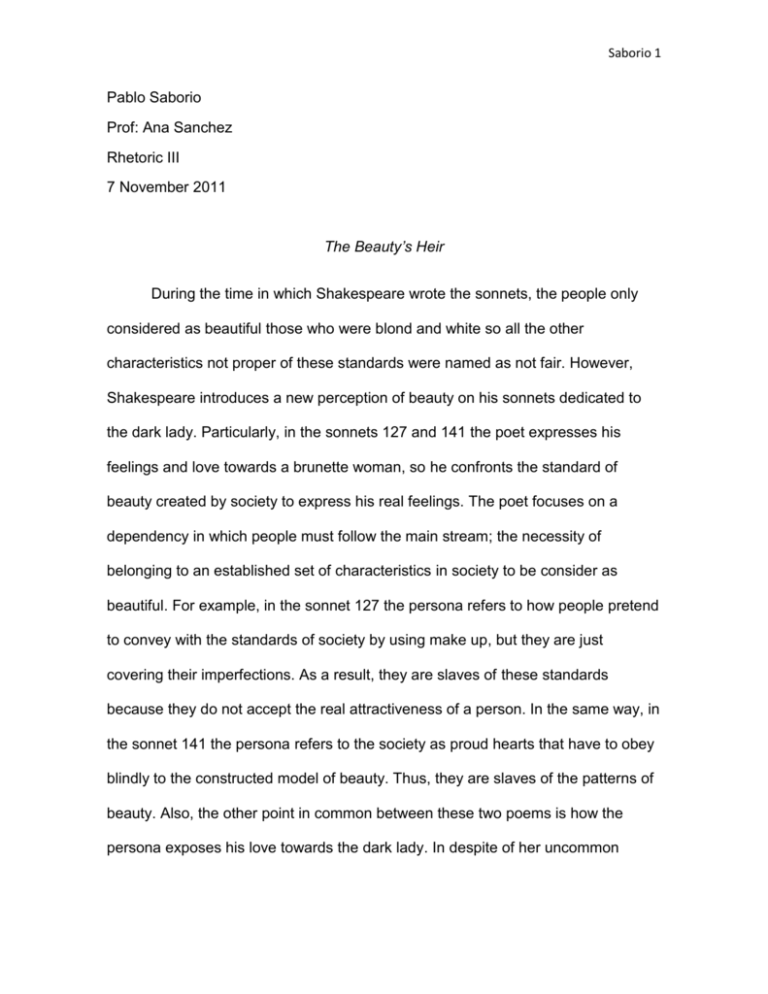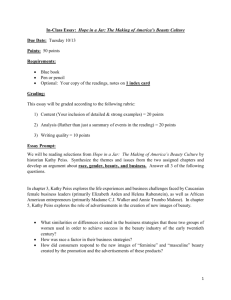essay_sonnets_127_and_141
advertisement

Saborio 1 Pablo Saborio Prof: Ana Sanchez Rhetoric III 7 November 2011 The Beauty’s Heir During the time in which Shakespeare wrote the sonnets, the people only considered as beautiful those who were blond and white so all the other characteristics not proper of these standards were named as not fair. However, Shakespeare introduces a new perception of beauty on his sonnets dedicated to the dark lady. Particularly, in the sonnets 127 and 141 the poet expresses his feelings and love towards a brunette woman, so he confronts the standard of beauty created by society to express his real feelings. The poet focuses on a dependency in which people must follow the main stream; the necessity of belonging to an established set of characteristics in society to be consider as beautiful. For example, in the sonnet 127 the persona refers to how people pretend to convey with the standards of society by using make up, but they are just covering their imperfections. As a result, they are slaves of these standards because they do not accept the real attractiveness of a person. In the same way, in the sonnet 141 the persona refers to the society as proud hearts that have to obey blindly to the constructed model of beauty. Thus, they are slaves of the patterns of beauty. Also, the other point in common between these two poems is how the persona exposes his love towards the dark lady. In despite of her uncommon Saborio 2 attractiveness to the lover, the persona uses his true feelings to escape from the prison of Elizabethan standards. In the sonnet 127, the persona confronts the standards of beauty during the Elizabethan time by considering a brunette girl, the dark lady, an attractive, natural and beautiful woman. The poem starts by exposing the belief that only white and blond women were considered beautiful, so brunette females were out of the patterns of beauty established by society. To exemplify, the first two lines show how they were not called beautiful because of their distinctive features. However, on the last two lines of the first quatrain, the speaker starts to perceive brunettes as beautiful. Mainly, the speaker says that black is the heir of beauty, so brunettes are going to become the new standard of beauty. As a matter of fact, the persona says that beauty is slandered with a bastard shame because beauty was based on general features of a person, not on the particularities of a human being. One can notice the last asseverations on the next quatrain: In the old age black was not counted fair. Or, if it were, it bore not beauty´s name. But now is black beauty´s successive heir, And beauty slandered with a bastard shame; (1-4) In addition, another aspect that was exposed by the persona in this sonnet is the real beauty or the natural attractiveness of a person. According to the poem, beauty was provided to the individual by the nature when the person was born. If Saborio 3 women used cosmetics to improve their appearance, this will be as false as borrowing the face of another human being. Also, when he refers to the mistress, the persona says that beauty should have no name and not a holy bower. Thus, a particular kind of women cannot be consider beautiful just by fulfilling the general characteristics of what society believes is attractive. Principally, because what is beautiful does not reside in a trait such as black or white, but to the physical qualities provided by nature. The last statements can be perceived from the following quatrain: For since each had hath put on nature´s power, Fairing the foul with art´s false borrowed face, Sweet beauty hath no name, no holy bower, But is profaned, if not lives in disgrace. (5-8) Moreover, the persona refers to the mistress, who has eyes as black as a raven and do not born fair to allude to her color. So, one can notice that the dark lady was not consider beautiful because of her looks; however, the persona says “Sland´ ring creation with a false esteem” (12) to acknowledge the erroneous concept of beauty of that time. Because being blond and white was the only synonym of beauty, anything different was not consider attractive. In addition, on the couplet, one can infer that the speaker states that brunettes have to suffer because of the preconceived concepts of beauty. Saborio 4 In the sonnet 141, the persona exposes the true love that can surpass social standards and appearances to omit senses perception and express true feelings. Firstly, the person starts clarifying that he does not love the dark lady with his eyes because they will only notice the imperfections on her. Thus, the visual flaws represent indirectly how people identify the dark lady as unattractive. However, the heart symbolizes the feelings of the persona, and how he is able to love her without boundaries. Since the looks were highly important during the time, the last statement of the persona has a relevant impact because he loves what the other people consider repulsive. As a consequence, the persona goes against the main stream and their standards. One can notice the last asseveration on the following extract from the sonnet. In faith, I do not love thee with mine eyes, For they in thee a thousand errors note; But 'tis my heart that loves what they despise, Who in despite of view is pleased to dote;(1-4) In addition, the persona speaks about how his senses such as hearing, taste, smell and view have make him unpleased ; even to the point to not be sexually attracted to her. One can notice on the next extract the reason of the last statement because the persona is not able to find the beauty and sexual attraction on her. Nor are mine ears with thy tongue's tune delighted, Nor tender feeling, to base touches prone, Saborio 5 Nor taste, nor smell, desire to be invited To any sensual feast with thee alone. (1-8) Particularly, on the ninth line, the persona establishes a contrast of the perception of the dark lady since now the lover with his senses cannot stand against the power of his heart. Moreover, the persona shows how the heart or true love can surpass what the senses can perceive; by consequence, the lover fights against society because during that time and nowadays our perceptions of beauty are set up by the main stream. Furthermore, as the persona loves the dark lady besides her differences, he is exposed to be criticized by people who follow that concept. He attacks this perception by considering the people who follows it a slave or subordinate of society, and that this concept will make the person be just a semblance of a man. One can infer the last asseverations from the following extract: But my five wits nor my five senses can Dissuade one foolish heart from serving thee, Who leaves unsway'd the likeness of a man, Thy proud hearts slave and vassal wretch to be. (9-12) Moreover, on the heroic couplet, the persona has to face the difficulties of omitting the standard concept, so he called it his plague. Nevertheless, the plague which represents the entire struggle that he has to overcome will become his freedom from the chains of society. At the same time, the persona suffers this change in his perception due to the difficulty of choosing and loving an unappealing Saborio 6 person. In addition, the lover confronts the majority by hearing his heart, and changing his perception towards the beloved. By consequence, this change will bring pain to him and will change his choices in life. When someone receives pain he reacts to it, so in the poem, the lover obeys his heart and rejects the concepts of beauty created during that time. In despite of the similarities between these two sonnets, they have contrasting ideas in regards to the beauty of the dark lady and to the concept of beauty. To exemplify, in the sonnet 127 the persona believes that the dark lady is beautiful even when she does not have the characteristics of a white woman, but he believes that the dark lady is so beautiful that black is going to be the new meaning of beauty. On the other hand, in the sonnet 141the lover says that the dark lady is not appealing to his eyes, hearing, taste and sexual attraction but is his heart which appreciates the real beauty of the beloved and not her appearance. In addition, on the sonnet 127 the lover has a concept of beauty that can be moved from a person which some characteristics to another one; by consequence, the concept of beauty changes from one host with determine features to a different host with a totally different qualities. On the contrary, on the sonnet 141 the persona believes that beauty should not depend of social standards but to be based on what the person feels for the beloved one. To conclude, both poems have more similarities than differences but the concept that beauty should not be related to social standards forms as part of one of the main ideas in these sonnets. Saborio 7 Works Cited Shakespeare, William. “Sonnet 127”. The Norton Anthology of English Literature, 1993. Shakespeare, William. “Sonnet 141”. The Norton Anthology of English Literature, 1993.





